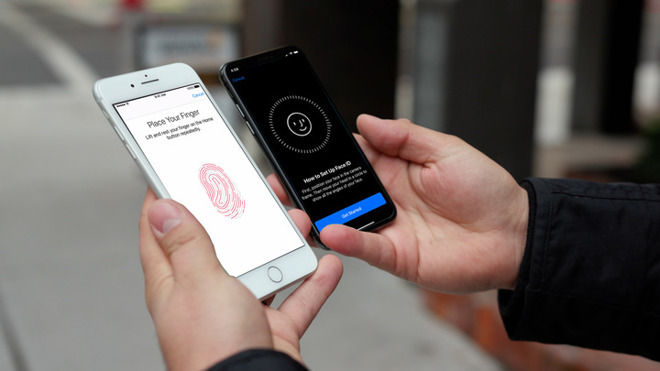Unsurprisingly, Apple does not plan to integrate fingerprint sensors under the screen of its 2019 iPhone, leaving the field open for Android adoption.
In a note seen by AppleInsider, Ming-Chi Kuo of TF International securities believes that Apple has left Touch ID behind for full-screen iPhones, at least in the near term. Reasons cited include little backlash from Face ID on the iPhone X, as well as higher than expected "user feedback" to the inclusion of fingerprint sensors under the screen of the Vivo X21.
Android manufacturers seem likely to jump on it as a differentiating factor, despite the middling response to it on the X21. Additionally, existing facial recognition systems on Android devices aren't as secure as Apple's implementation, and have been fooled by photographs.
Kuo expects that the Samsung Galaxy S10 in the spring of 2019 will adopt a fingerprint sensor embedded in the screen.
In 2017, Kuo expected yearly shipments of Android devices equipped with 3D sensing components to outnumber those with under-display optical recognition by two or three times over the next two to three years.
"3D sensing not only enables facial recognition in security applications and allows users to create fun expressions like Apple's Animoji, on a more important level, it is a key factor in the development of AR," Kuo wrote. "We therefore believe brand vendors are willing to spend more for related components."
This year, the analyst is expecting the fingerprint under display technology to grow 500 percent year-over-year through 2019, meaning to only about 15 million units in total, based on an estimate of 3 million X21 sales to date.
Wider adoption is expected with time, given maturation of the fingerprint sensing technology, and the relatively lower cost of implementation versus a secure depth-mapping facial recognition system.
 Mike Wuerthele
Mike Wuerthele








 Charles Martin
Charles Martin
 Christine McKee
Christine McKee
 Wesley Hilliard
Wesley Hilliard
 Malcolm Owen
Malcolm Owen
 Andrew Orr
Andrew Orr
 William Gallagher
William Gallagher
 Sponsored Content
Sponsored Content







66 Comments
If TouchID was so great Apple would use it. Clearly FaceID is better.
Can you use screen touch ID through a screen protector?
The fact that Apple jumped over through the screen touchID tells me there is some short of flaw in the technology which apple was not able to over come and everyone else decide to just ignore and let the users deal with it. I am think that you have to give up some level of display/image quality to make it work.
I also believe competitors are not going the face ID route since it is a very hard software and hardware problem to solve, Apple owns most of the IP (China will shameless steal it), lastly Apple is controlling most of the supply chain for the part to make it work, there is no capacity to supply parts to other companies. We are probably still a year or more away until more capacity is online.
I would be surprised if Apple brought touchID back. Historically, once Apple is done with piece of technology and moved on, they are done with it for good. Plus, it might not be superior technology to current implementation of touchID. The button shape guided the user's finger. On blank screen, how would the user find, place the finger in the right area? Especially in the dark? I think that's why Apple didn't move to this implementation.